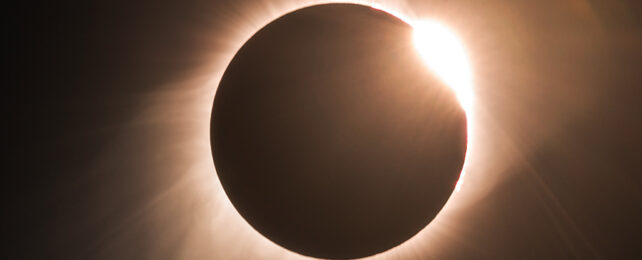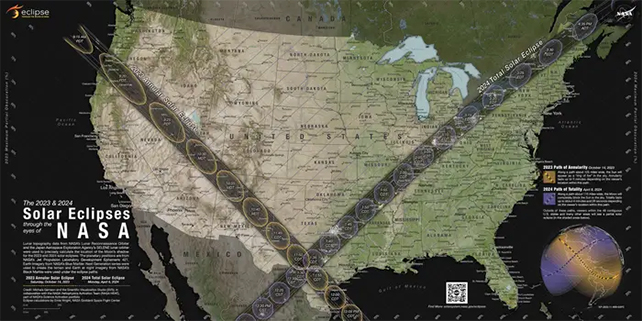 2017 solar eclipse as seen from Wyoming, US. (john finney photography/Getty Images)
2017 solar eclipse as seen from Wyoming, US. (john finney photography/Getty Images)Millions of people will be able to don protective glasses and view a spectacular total solar eclipse on April 8, 2024, starting around 1 pm CT.
If this sounds familiar, it's because in 2017, a 70-mile-wide band of the US saw a total solar eclipse, while many other areas saw a partial eclipse. People drove across states and gathered near planetariums just to see those fleeting minutes when, in the middle of the day, the sky went dark.
But the total eclipse coming in April will be even cooler, excited NASA scientists told reporters at an American Geophysical Union meeting.
"Those of us who've seen eclipses know that you want to see your next one," Kelly Korreck, NASA's program manager for the 2024 solar eclipse, said during a roundtable at the meeting.
She added that having one in such recent memory likely has many people excited for this year's.
While total solar eclipses aren't exactly rare, there are a few circumstances around this upcoming event that make it unique, from its path across the US to an abundance of solar activity to a plethora of scientific projects that NASA and others have planned for the few minutes when the Moon will seem to cover the Sun.
Over 30 million people will be able to see the total solar eclipse
There are three types of solar eclipses:
- an annular eclipse appears as a bright ring around the Moon
- a partial eclipse only partly blocks the Sun
- in a total eclipse, the Moon seems to cover the Sun entirely
In 2017, the continental US had its first coast-to-coast total eclipse since 1918. Portions of 14 states were in the path, but populated cities like Atlanta and Charlotte, North Carolina, were not.
This year, more people will be able to see the eclipse without having to travel.
The path spreads from Mexico to northeastern Canada.

"This is going to be the most populated eclipse in the US, with 31.5 million people able to just walk outside of their homes and experience this event," Korreck said.
Dallas, Cleveland, and Indianapolis are all positioned for prime total eclipse viewing.
The eclipse will last slightly longer than the last one did
Depending on your location, you'll have about 3 to 4 minutes to watch the Moon blot out the Sun.
That peak of the eclipse, called totality, will last slightly longer than the one in 2017 did, Korreck said.
US residents who miss this year's eclipse will have to wait another couple of decades for a similar event. The next total solar eclipses visible in the contiguous US will be in 2044 and 2045, but neither will cut through Cleveland or Indianapolis.
"You're not going to get another eclipse for quite a while," Korreck said.
An active sun should make for incredible viewing
In 2017, the Sun was fairly quiet during the eclipse. As it approaches its solar maximum, it's been spitting out solar flares.
Korreck hopes to see a coronal mass ejection during the eclipse. CMEs are high-speed blobs of plasma that erupt out of the sun's corona, or outer layer.
"You would see that kind inky mass just leave the Sun at that point in time," Korreck said. "So it would be pretty spectacular."
If that happens, Korreck said there should be increased aurora borealis activity a few days later. Even if there's no CME, the images could be more dynamic than in 2017, with more whisp-like prominences radiating from the Sun.
"It should be a very complex-looking Sun," Korreck said.
Balloons, rockets, and citizen scientists will be tracking the eclipse
There's a reason solar eclipses are a big deal in the scientific community. "They provide you with the opportunity to do experiments that you cannot do otherwise," Nour E. Raouafi, an astrophysicist with Johns Hopkins University, said during the roundtable.
An eclipse in 1919 proved Albert Einstein's theory of relativity, he said.
This will probably be the most observed total solar eclipse in history.
That's because NASA and other institutions will be using radar, balloons, spacecraft, and jets to perform experiments and gather data during the eclipse. NASA is interested in tracking changes to density, wind speed, and temperatures at the ionosphere – part of the Earth's upper atmosphere – during the event.
Unlike the 2017 eclipse, there are now two Sun-scrutinizing spacecraft circling our star. It's an opportunity NASA has never had before – to monitor the Sun up close, from two different space observatories, while instruments here on Earth study the eclipse.
That should give scientists more comprehensive eclipse data than they've ever had.
There are tons of citizen scientist projects taking place, too. NASA is hoping people will use their Ham radios, telescopes, cameras, and phones to record images, sounds, and observations during the eclipse.





No comments:
Post a Comment